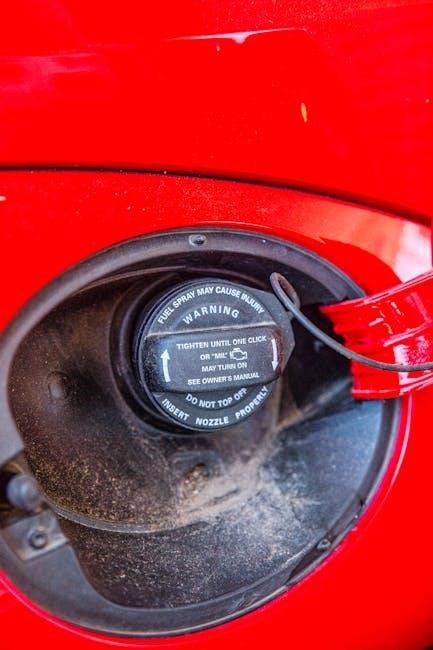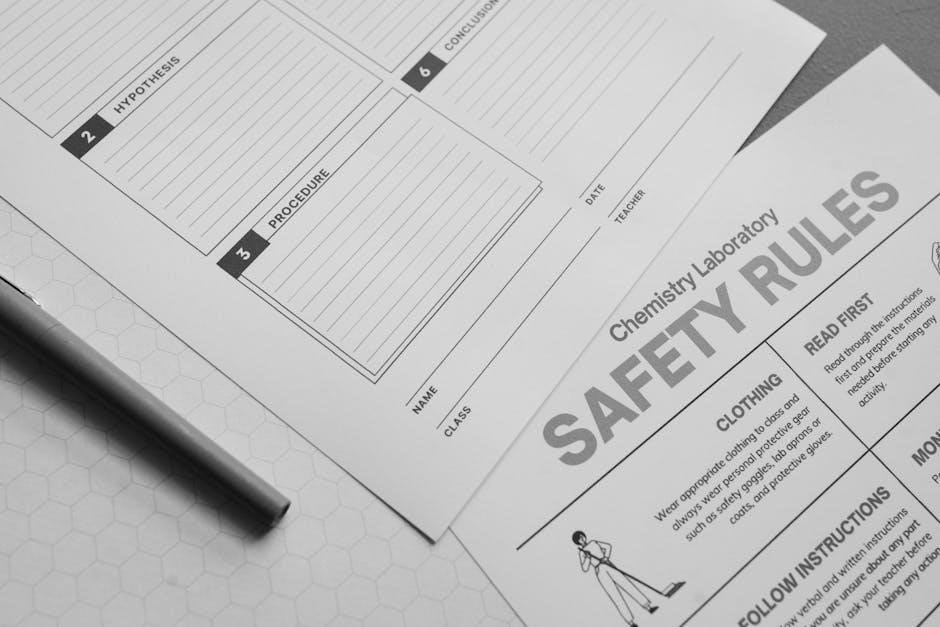The GE Dehumidifier is a high-efficiency appliance designed to remove excess moisture from the air, ensuring a comfortable and healthy indoor environment while preventing mold growth.
1.1 Overview of the GE Dehumidifier
The GE Dehumidifier is an advanced appliance designed to efficiently remove excess moisture from indoor spaces, improving air quality and comfort. It is equipped with cutting-edge features like a built-in humidity sensor, adjustable settings, and a quiet operation mode. The unit is energy-efficient and comes with a reliable drainage system, making it suitable for various environments. Its compact design and user-friendly interface ensure easy operation and maintenance. Whether for residential or commercial use, the GE Dehumidifier is a trusted solution for maintaining a dry, healthy, and comfortable atmosphere while preventing mold and mildew growth.
1.2 Importance of Proper Usage
Proper usage of the GE Dehumidifier is essential for ensuring optimal performance, safety, and energy efficiency. By following the guidelines outlined in the instruction manual, users can effectively remove excess moisture, reduce humidity levels, and prevent mold growth. Proper usage also helps maintain the appliance’s longevity and prevents potential hazards such as electrical issues or water leakage. Adhering to the recommended settings and maintenance routines ensures the dehumidifier operates efficiently, providing a healthy and comfortable indoor environment while minimizing energy consumption and environmental impact. Always refer to the manual for specific instructions tailored to your model and needs.
1.3 Safety Precautions
To ensure safe operation of the GE Dehumidifier, always follow the safety guidelines provided in the manual. Place the unit on a stable, level surface away from direct sunlight and heat sources. Keep children and pets away from the appliance to avoid accidental injuries. Never submerge the dehumidifier in water or expose it to excessive moisture, as this could lead to electrical hazards. Avoid overloading the drainage system and ensure proper ventilation in the room. Regularly inspect the power cord and plug for damage, and unplug the unit when cleaning or performing maintenance. Always adhere to the manufacturer’s instructions to prevent risks of fire, electrical shock, or other accidents.

Key Features of the GE Dehumidifier
The GE Dehumidifier offers exceptional performance with its energy-efficient design, quiet operation, and advanced features like a built-in humidity sensor and a reliable drainage system for optimal moisture control.
2.1 Built-in Humidity Sensor
The GE Dehumidifier features a built-in humidity sensor that continuously monitors moisture levels in the air. This advanced sensor ensures the unit operates efficiently by automatically adjusting its settings based on the surrounding humidity. It helps maintain a consistent humidity level, preventing excessive dryness or moisture buildup. The sensor is crucial for optimal performance, as it enables the dehumidifier to react dynamically to changes in the environment. This feature not only enhances comfort but also helps preserve energy by avoiding unnecessary operation. The sensor’s accuracy ensures the unit runs only when needed, making it both effective and energy-conscious.
2.2 Adjustable Humidity Settings

The GE Dehumidifier offers adjustable humidity settings, allowing users to customize the moisture level in their space. This feature enhances comfort by enabling precise control over humidity, ensuring the environment remains pleasant and free from mold growth. With settings typically ranging from 30% to 80% relative humidity, users can adjust according to their preferences or specific room conditions. This adjustability also promotes energy efficiency, as the unit operates based on actual humidity levels rather than running continuously. Easy-to-use controls make it simple to set and maintain the desired humidity, ensuring optimal performance and user satisfaction.
2.3 Energy Efficiency
The GE Dehumidifier is designed with energy efficiency in mind, featuring advanced components that minimize energy consumption while maintaining optimal performance. By using a high-efficiency compressor and smart sensors, the unit reduces unnecessary power usage. This ENERGY STAR® certified appliance ensures lower energy bills and reduced environmental impact. The adjustable humidity settings and automatic shutoff further contribute to energy savings by preventing over-operation. Proper maintenance, such as cleaning filters and ensuring proper airflow, also enhances efficiency. Following the manufacturer’s guidelines helps maximize energy savings while keeping your space comfortable and dry.
2.4 Quiet Operation
The GE Dehumidifier is engineered for quiet operation, making it ideal for bedrooms, living areas, or offices. Its advanced fan design and noise-reducing insulation minimize operational noise, ensuring a peaceful environment. The unit operates at a low decibel level, even on higher settings, allowing you to run it without interruptions. Proper placement, such as keeping it away from walls and obstructions, further enhances its quiet performance. Regular maintenance, like cleaning the air filter, helps maintain its noise level. This feature ensures comfort and convenience while effectively managing humidity levels in your space.
2.5 Drainage System
The GE Dehumidifier features a reliable drainage system designed for efficient moisture removal. The built-in water tank collects condensate, and when full, the unit automatically shuts off to prevent overflow. For added convenience, the dehumidifier supports continuous drainage via a hose connection, allowing water to flow directly into a drain. This dual functionality ensures uninterrupted operation and reduces the need for frequent emptying. Regularly checking and cleaning the drainage system is essential to maintain performance and prevent blockages. A well-maintained drainage system ensures the dehumidifier operates smoothly and effectively controls humidity levels in your space.

Installation and Placement
Ensure proper installation by placing the dehumidifier on a level surface in a well-ventilated area, away from direct sunlight and heat sources for optimal performance.
3.1 Choosing the Right Location
Selecting the right location for your GE dehumidifier is crucial for optimal performance. Place it in areas with high humidity, such as basements or laundry rooms. Ensure the unit is at least 6 inches away from walls and obstructions to allow proper airflow. Avoid placing it near heating vents or direct sunlight, as this can interfere with its operation. The location should also provide easy access for maintenance and drainage. Additionally, ensure the area is within the dehumidifier’s recommended operating temperature range (41°F to 96°F) for efficient moisture removal.
3.2 Leveling the Unit
Proper leveling of your GE dehumidifier ensures efficient operation and prevents water leakage. Use a spirit level to verify the unit is perfectly horizontal. If necessary, adjust the feet to achieve balance. Ensure the surface is even and sturdy to support the dehumidifier’s weight. Failure to level the unit may result in poor performance or damage to internal components. Always refer to the manufacturer’s guidelines for specific leveling instructions to maintain optimal functionality and safety. Regularly check and adjust the leveling as needed, especially if the unit is moved to a different location.
3.3 Distance from Walls and Obstructions
Ensure the GE dehumidifier is placed at least 6-12 inches away from walls and obstructions to maintain proper airflow. This distance prevents air recirculation, ensuring efficient moisture removal. Keep the surrounding area clear of objects to avoid blocking the intake or exhaust, which could hinder performance. Proper spacing also aids in reducing noise levels and promotes even air circulation in the room. Always follow the manufacturer’s guidelines for optimal placement and functionality of your dehumidifier.
3.4 Proper Ventilation
Ensure the room has proper ventilation when using the GE dehumidifier to maintain efficient operation; Open doors or windows slightly to allow fresh air circulation, preventing stale air from accumulating. Proper ventilation helps the dehumidifier function effectively by enabling continuous airflow. Avoid placing the unit in tightly sealed spaces, as this can reduce performance and lead to inefficient moisture removal. Maintaining good airflow also helps prevent mold growth and ensures a healthier indoor environment. Always prioritize ventilation to optimize the dehumidifier’s performance and extend its lifespan.

Operating the GE Dehumidifier
Operating the GE dehumidifier involves turning it on, adjusting humidity levels, and monitoring performance. Regularly check filters and drainage systems for optimal function and energy efficiency.
4.1 Turning On the Dehumidifier
To turn on the GE dehumidifier, first ensure it is properly plugged into a grounded electrical outlet. Place the unit on a level surface and check that the power cord is securely connected. Press the power button, usually located on the control panel, to activate the device. Ensure the air filter is clean and the drainage system is properly set up before operation. Set your desired mode, such as continuous or automatic, using the control panel. The built-in humidity sensor will automatically adjust to maintain the selected moisture level. Always follow safety guidelines and ensure the surrounding area is clear of obstructions. Keep children and pets away during operation.
4.2 Adjusting the Humidity Level
To adjust the humidity level on your GE dehumidifier, use the control panel to select your desired setting. The built-in humidity sensor allows you to set the target relative humidity between 30% and 80%. For most homes, a range of 30-50% is ideal to prevent mold growth and dust mites. Press the humidity adjustment buttons to increase or decrease the level. The device will automatically adjust its operation to maintain the selected setting; For optimal performance, monitor the humidity level and adjust as needed based on the room’s conditions. Regularly check the settings to ensure they align with your comfort preferences.
4.3 Setting the Fan Speed
To set the fan speed on your GE dehumidifier, use the control panel buttons. The unit typically offers multiple fan speed options, such as low, medium, and high. Select a lower speed for quieter operation or when less moisture removal is needed. Higher speeds are ideal for faster dehumidification in humid environments. Some models also feature an automatic mode that adjusts the fan speed based on the humidity level. Choose the speed that best suits your needs to balance noise and performance. Adjustments can be made at any time during operation.
4.4 Using the Drain System
Your GE dehumidifier is equipped with a drainage system to manage the water it collects. For manual drainage, empty the water bucket when the “Bucket Full” indicator lights up. For continuous drainage, connect a hose to the drain port and direct it to a suitable drain location. Ensure the hose is securely attached and free of kinks to prevent water flow issues. Regularly check the drain system for blockages to maintain proper function. Refer to your model’s specifications for recommended hose sizes and setup instructions to ensure efficient operation.

Maintenance and Cleaning
Regular maintenance ensures optimal performance. Clean the air filter monthly and inspect coils for dust buildup. Check the drainage system for blockages and ensure proper airflow.
5.1 Cleaning the Air Filter
Cleaning the air filter is essential for maintaining your GE dehumidifier’s efficiency. Turn off and unplug the unit before starting. Remove the filter and gently brush off dust with a soft cloth or vacuum cleaner. For stubborn dirt, dampen a cloth with water, but avoid harsh chemicals. Allow the filter to dry completely before reinstalling. Clean the filter monthly or as needed, depending on usage; A clean filter ensures better airflow, reduces energy consumption, and prevents mold growth. Always follow the manufacturer’s guidelines for optimal performance.
5.2 Maintaining the Coils
Maintaining the coils is essential for optimal performance. Turn off and unplug the dehumidifier before cleaning. Use a soft brush or vacuum cleaner to gently remove dust and debris from the coils. Avoid using harsh chemicals or abrasive materials, as they may damage the surface. Check the coils monthly or as needed, especially in dusty environments. Clean coils ensure efficient heat transfer, reduce energy consumption, and prevent mold buildup. Regular maintenance also extends the lifespan of your GE dehumidifier and ensures reliable operation.
5.3 Checking the Drainage System
Regularly inspect the drainage system to ensure proper water flow. Locate the drain hose at the back or bottom of the unit. Check for kinks, bends, or blockages that could restrict water flow. Ensure the hose is securely connected to both the dehumidifier and the drain or bucket. If connected to a bucket, verify it empties correctly and monitor the full indicator. For direct drain connections, ensure the pipe is secure and leak-free. Periodically clean the system with a water and vinegar solution to remove buildup. Inspect the hose for wear or damage, replacing it if necessary. Perform these checks monthly or as recommended in the manual to maintain efficiency and prevent water issues.

Troubleshooting Common Issues
Troubleshoot common problems like the dehumidifier not turning on, insufficient moisture removal, or excessive noise. Check power connections, filters, and settings. Refer to sub-sections for detailed solutions.
- Power issues or faulty sensors.
- Clogged air filters or blocked drainage;
- Incorrect humidity settings or fan speed.
6.1 Dehumidifier Not Turning On
If the dehumidifier fails to turn on, check the power cord connection and ensure it is plugged into a working outlet. Verify that the circuit breaker or fuse hasn’t tripped. Press the power button firmly to ensure it is engaged. If the unit has a child lock feature, ensure it is disabled. Check for any blockages or damage to the power button. If issues persist, inspect the internal sensors, as they may detect improper conditions. Contact customer support if the problem continues after these steps.
- Check power cord and electrical connections.
- Inspect circuit breaker or fuse box.
- Verify child lock feature is disabled.
- Test the power button for proper function.
6.2 Insufficient Moisture Removal
If the dehumidifier isn’t removing enough moisture, check the room size to ensure it matches the unit’s capacity. Verify the humidity setting is low enough and the built-in sensor is functioning. A dirty air filter or blocked vents can reduce efficiency. Ensure the unit is level and placed away from walls. Check for proper drainage; a full tank or clogged drain can halt operation. If issues persist, inspect the refrigerant coils for dust or ice buildup. Clean or replace parts as needed to restore performance.
- Ensure room size matches dehumidifier capacity.
- Confirm humidity settings and sensor function.
- Inspect and clean air filter and vents.
- Check drainage system for blockages.
6.3 Excessive Noise
If the GE dehumidifier is operating louder than usual, ensure it is placed on a level surface. Uneven installation can cause vibrations and noise. Check for loose internal components or debris inside the unit. Ensure proper clearance from walls and furniture to prevent sound amplification. A dirty fan or misaligned fan blades may also contribute. Clean the air filter and inspect vents for blockages; If noise persists, refer to the maintenance section for further troubleshooting or contact customer support.
- Ensure the unit is level and stable.
- Check for loose parts or debris inside.
- Keep the unit away from walls and furniture.
- Clean the fan and air filter regularly.
- Inspect vents for blockages or damage.
6.4 Water Leakage
Water leakage from the GE dehumidifier may occur due to improper drainage system setup. Ensure the drain hose is securely connected and free from kinks or blockages. If using a drainage bucket, check that it is correctly aligned and not full; Additionally, verify that the drainage path is clear and the unit is properly leveled. If water continues to leak, inspect the internal drain system for damage or misalignment. Refer to the maintenance section for cleaning instructions or contact customer support if the issue persists.
- Check the drain hose for kinks or blockages.
- Ensure the drainage bucket is properly aligned and not full.
- Verify the unit is level and stable.
- Inspect the internal drain system for damage.

Energy Efficiency Tips
Optimize energy use by adjusting humidity settings according to room conditions. Use the built-in sensor for automatic efficiency. Ensure proper airflow for consistent performance and lower consumption.
- Set humidity levels between 30-50% for optimal efficiency.
- Use the built-in sensor for automatic adjustments.
- Ensure proper airflow around the unit.
7.1 Optimal Usage Guidelines
For maximum efficiency, operate the dehumidifier in spaces with humidity levels above 50%. Adjust settings based on room size and moisture content. Use the built-in sensor to monitor and maintain ideal humidity levels automatically. Ensure proper airflow by placing the unit away from walls and obstructions. Regularly clean the air filter to prevent reduced performance. Avoid overloading the unit, as this can increase energy consumption. Always unplug the device during cleaning or maintenance to ensure safety and efficiency.
- Monitor humidity levels to avoid over-dehumidification.
- Keep the unit away from direct sunlight and heat sources;
- Empty the water tank regularly to maintain efficiency.
7.2 Reducing Energy Consumption
To minimize energy use, set the dehumidifier to run only when needed. Use the programmable timer to operate the unit during off-peak hours or when humidity levels are highest. Adjust the humidity settings lower than necessary to avoid overcooling. Ensure proper ventilation in the room to optimize performance. Regularly clean the air filter to maintain airflow efficiency. Consider using the built-in humidity sensor for automatic operation, which adjusts energy use based on real-time conditions. This balances effectiveness and energy savings.
- Use the timer to limit operation to essential periods.
- Avoid setting humidity levels too low to reduce runtime.
- Keep the unit well-maintained for optimal performance.
7.3 Seasonal Usage Recommendations
Adjust your GE dehumidifier usage according to the season for optimal performance and energy efficiency. During humid seasons, run the dehumidifier continuously to maintain a relative humidity of 30-50%. In drier months, reduce the frequency of use to avoid over-drying the air, which can also help reduce energy consumption. Store the unit in a cool, dry place during the off-season, ensuring the tank is empty and the filter is clean. This will prevent mold growth and maintain efficiency for future use. Regular maintenance during storage ensures it’s ready when needed again.

Safety Tips and Precautions
Always read the manual and understand settings before use. Avoid electrical hazards by keeping the unit away from water. Ensure proper ventilation to prevent mold growth. Keep children and pets away from the dehumidifier. Follow all safety guidelines to ensure efficient and safe operation.
8.1 Avoiding Electrical Hazards
To ensure safe operation, keep the dehumidifier away from water sources and avoid exposing it to moisture. Never submerge the unit in water or operate it in wet conditions. Use the provided power cord and avoid damaged or frayed cords. Ensure the unit is installed on a level surface to prevent tip-overs. Avoid using extension cords, as they may cause electrical issues. Keep the dehumidifier at least 6 inches away from any walls or obstructions to maintain proper airflow and reduce fire risks. Always unplug the unit before cleaning or performing maintenance.
8.2 Preventing Mold Growth
To prevent mold growth, ensure the dehumidifier operates in areas with proper ventilation. Maintain humidity levels between 30-50% to inhibit mold formation. Regularly clean the air filter and check for dust buildup, as moisture combined with dust can foster mold. Empty the water tank daily and dry it thoroughly to prevent standing water. If using a condensate pump, ensure it functions correctly to avoid water accumulation. Clean the dehumidifier coils periodically to remove dirt and moisture. Lastly, inspect the unit for leaks and address them promptly to avoid moisture-related issues.
8.3 Keeping Children and Pets Away
Ensure the GE dehumidifier is placed out of reach of children and pets to avoid accidental injuries or damage. Keep the unit in a stable, elevated location to prevent it from tipping over. Avoid letting children play with the controls or water tank, as this could lead to improper operation or water spills. Secure the area around the dehumidifier to prevent pets from chewing on cords or accessing internal components. Supervise children when they are near the appliance and teach them not to touch it. This ensures both safety and optimal performance of the dehumidifier.

Warranty and Customer Support
The GE dehumidifier is backed by a comprehensive warranty. For assistance, contact GE’s customer support team via phone, email, or the official website. They provide guidance, troubleshooting, and repair services to ensure optimal performance and address any concerns promptly.
9.1 Understanding the Warranty
The GE dehumidifier warranty covers parts and labor for defects in materials and workmanship. The standard warranty period is one to two years, depending on the model. Proper registration may extend warranty benefits. Coverage excludes damage from misuse, improper installation, or neglect. For claims, retain the purchase receipt as proof of ownership. Review the warranty certificate for specific terms and conditions. Contact GE customer support for detailed information or assistance with warranty-related inquiries.
9.2 Contacting Customer Service
To contact GE customer service, visit their official website for support options. Use the live chat feature or submit a request form for assistance. You can also call the dedicated customer service hotline, available Monday through Friday during business hours. For email inquiries, include your model number and a detailed description of your issue. Ensure you have your product’s serial number ready for faster service. Representatives are trained to address warranty claims, troubleshooting, and maintenance scheduling efficiently. Always verify contact information through official GE channels to avoid unauthorized support.
9.3 Scheduling Maintenance
To ensure optimal performance, schedule regular maintenance for your GE dehumidifier. GE recommends professional servicing at least once a year to inspect and clean internal components. Use the GE Appliances website or mobile app to book certified technicians. Additionally, refer to the manual for DIY maintenance tasks, such as filter cleaning and coil inspection. Scheduling maintenance helps prevent breakdowns and maintains energy efficiency. Keep records of all services for warranty validation. For convenience, GE offers online scheduling and customer support to arrange appointments tailored to your needs.